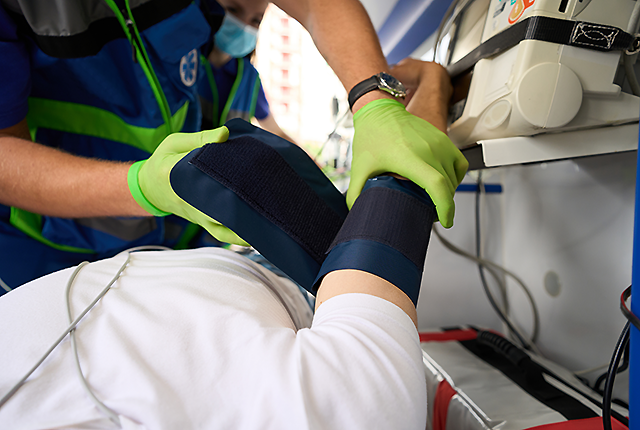
Could a blood pressure cuff help cardiac arrest survivors?
People who are resuscitated after an out-of-hospital cardiac arrest are fortunate, but their next three days can be precarious.
These patients typically experience some degree of reperfusion injury: cellular-level inflammation caused by a flood of cytokine proteins circulated when blood flow is restored with the heart’s renewed pulse.
Doctors see a correlation between elevated levels of these inflammatory proteins and patients’ recoveries after their blood flow is initially restored.
Researchers at the University of Washington School of Medicine recently conducted a study of patients who had received life-saving resuscitation and been brought to Harborview Medical Center in Seattle. They were testing an approach that aims to reduce reperfusion injury by applying a blood pressure cuff to a patient’s arm.
“From studies of patients with other emergencies, such as heart attack, we know that putting a blood pressure cuff on the arm and inflating and deflating it triggers release of proteins from the muscle, which then circulate through the blood. This reduces the size of heart attacks and could reduce the inflammation associated with restored blood flow after cardiac arrest,” said Dr. Graham Nichol, professor (General Internal Medicine). He directs the UW Medicine-Harborview Center for Prehospital Emergency Care and was the study’s lead investigator.
This pilot study included 30 patients who had experienced out-of-hospital cardiac arrest. Upon hospital arrival, 16 were randomly selected to receive the blood-pressure cuff test intervention and 14 received standard care. The study was conducted under an exception from informed consent because patients in this circumstance, though revived, are typically unconscious.
The researchers aimed to discern the feasibility and safety of adding the blood pressure cuff treatment while the patients received care in the Emergency Department. It did not measure whether the cuff application affected the volume of cytokines or protective proteins.
"We were testing whether we could get providers to put the cuff on and complete three cycles of inflation-deflation without interfering with emergency care and without any large, obvious adverse effect,” Nichol said. “We showed that.”
The study findings were published in the journal Resuscitation.
The next step, Nichol said, would be a larger trial to assess whether such use of a blood pressure cuff during resuscitation in the field is effective at decreasing morbidity and mortality with cardiac arrests that occur away from a hospital.
“I think further study is warranted, in part because blood pressure cuffs are ubiquitous, even in low-resource countries that don’t have access to fancy medicines or medical devices that we have access to here. If it works, this intervention would be broadly applicable.”
The research was supported by the Kettering Family Foundation and the ZOLL Foundation.